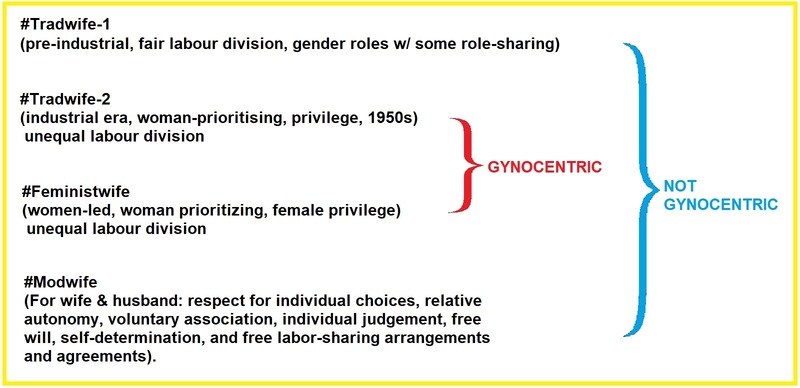Difference between revisions of "Modwife"
| Line 1: | Line 1: | ||
| − | A Modwife (noun), refers to women who have embraced multi-option lives over more traditional roles, and who |
+ | A Modwife (noun), refers to women who have embraced multi-option lives over more traditional roles, and who accept, and/or ''encourage'' multi-option lives for their husbands. The term was coined in response to the popular trend in [[Tradwife|Tradwives]] - ie. wives who enact or advocate a traditional gender role based on Western middle-class femininity of the mid twentieth century. Both the tradwife and modwife eschew feminist prescriptions for relationships, which are geared only to female domination and not to partnerships based on reciprocal labor, valorisation and devotion (for the feminist relationships model, see [[Gynowife]]).<ref>[https://gynocentrism.com/2020/01/19/tradwives-modwives-and-feminists/ Peter Wright, ''Tradwives, Modwives and Feminists'', A Voice for Men, 2020]</ref> |
==Philosophical outlook== |
==Philosophical outlook== |
||
Revision as of 06:08, 31 August 2021
A Modwife (noun), refers to women who have embraced multi-option lives over more traditional roles, and who accept, and/or encourage multi-option lives for their husbands. The term was coined in response to the popular trend in Tradwives - ie. wives who enact or advocate a traditional gender role based on Western middle-class femininity of the mid twentieth century. Both the tradwife and modwife eschew feminist prescriptions for relationships, which are geared only to female domination and not to partnerships based on reciprocal labor, valorisation and devotion (for the feminist relationships model, see Gynowife).[1]
Philosophical outlook
The unlikelihood that modern women will embrace 'Tradwife' roles of yesteryear with real commitment underpins attraction to the modwife option. At best, today’s multi-option women can invite their men to do same - to embrace multi-option lives. The modwife’s modus operandi is based on personal liberty within relationships, extending a freedom of opportunity to her partner such as society has championed for her.
Yet few multi-option women today are willing to extend that multi-option liberty to men, preferring instead to pocket the advantages extended by women’s ‘liberation’ while expecting their boyfriends and husbands to remain in the mismatched role of protector and provider. There are women however, limited in number as they are, who lean toward the model of commensurate liberty for both men and women in relationships — some of them will be recognized among the supporters of the men’s rights movement.
That libetarian spirit is usually understood as belonging to the political sphere, but it is accepted by the modwife as a guiding principle in her relationship with men. It emphasizes individual choice, relative autonomy, voluntary association, individual judgement, free will, self-determination, and free labor-sharing arrangements and agreements. In a word; freedom.[2]
The four relationship models
Below are the four relationship models alluded to in Peter Wright's introductory survey:[3]
Related terms
'Modwife' also implies a practice, hence Midwifery (Adj.) and can be referred to a collective of Midwives (Pl.). The compliment of a Modwife is a Modhusband, hence - Modcouple.
